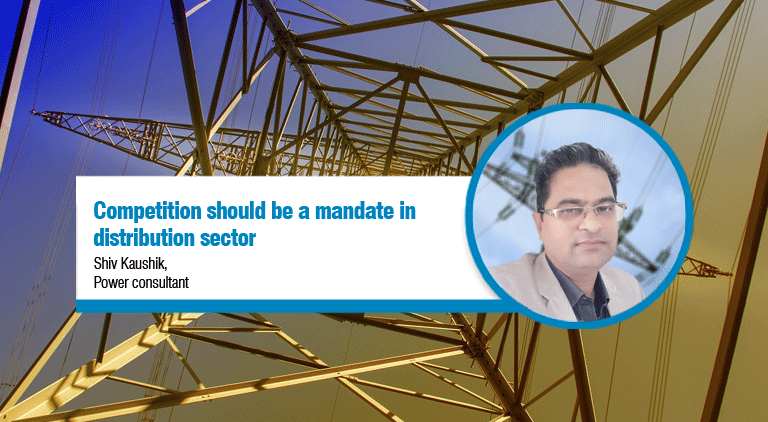Competition should be a mandate in distribution sector
By EPR Magazine Editorial January 10, 2020 11:22 am IST
By EPR Magazine Editorial January 10, 2020 11:22 am IST

Unless we do not bring competition to the distribution sector, we cannot curb the losses in generation sector.
Shiv Kaushik, Power consultant
Shiv Kaushik, Power consultant, explains why we have losses in generation, and how we can curb the same. He also discusses about IoT and Industry 4.0 being only few of the first steps towards smart electricity.
Your thoughts on opportunities explored in ELECRAMA
I am not participating in ELECRAMA this year, so I won’t be able to comment on this edition in particular. But it is definitely an event which showcases the entire electrical industry, not just in India but entire Asia-Pacific. It brings in a lot of new technology especially on the IoT side, which gets displaced by large leading multinational companies as well as Indian start-ups. So, it is definitely a good show in terms of what distribution and generation companies are doing in the market, as well as what large Indian and foreign electrical companies — including the solution providers of software and other digital grid solutions — are doing with the new age solutions that have been seen in ELECRAMA in most of the years I have attended. But as I am not attending it this year, I do not know who is participating in it.
How do you view the rise of IoT and Industry 4.0 transforming the sector?
I think people have been talking about IoT and digital grids for a very long time. But yes, earlier people used to think that they’re talking about very futuristic things, but now, it’s not the same. IoT is a very important factor and in the future, I think it will go further. As far as technology is concerned, a lot of new innovations are still happening here. We are able to generate data, but the more important thing is what do you do with that data; that is what is still lacking. IoT devices, unless clubbed with a very strong quality analytics, will not lead us to the desired place where all of us wanted this industry should go. It is simply that you have data, but you do not know what to do with it. So we need to bring quality analytics into the picture, with the help of the IoT and AI. That part is still lacking. I’m very optimistic about all the developments which are happening. It will take some more years for full transition, for which we have humongous amount of data about the equipment, about the weather and the different variables which makes decision making easier.
I think that the model which we started become privatised and we brought in competitition in the generation sector. But at the same time, we lost approximately $10 billion in distribution only. Around `45 lakhs per annum is lost into the distribution as we do not have a good billing system nor a good meter data management system, which are essential to make the distribution sector efficient. The government introduced RFP DRP, but everybody knows what is the status of RFP DRP; it still entangled in the bureaucratic battle between the Centre and state. Nobody takes the ownership and in tax `50,000 crore was spent. From now, we need to focus more on the supply than on the generation.
Can you brief about the latest innovations and additions for your institutions?
Smart city is really using the right kind of forecast forecasting system for both distribution and renewable generation. So, integration of renewable generation is very important to match the needs and demand. The problem is the other way round; today you have more electricity generation then consumption. So, we have the capacity of generating, say around 350 GW, but we are still not utilising it perfectly or optimally filling, let’s say, demand of around 170 GW. The important thing is that we should encourage use of electricity and bring the users to higher levels. So we have been working with all the stakeholders and the power grid to actually bring in an efficient grid balancing system. That is one area that we have been innovating quite a lot, but obviously smart meter has a very important role to play. And I think a lot of initiatives now have to come from the distribution companies too. We have been working very closely with the distribution companies in the market as well as media companies. We can bring a very innovative Indian model of successfully deploying a smart grid or smart liquid solution, because people have been talking what they have done globally, but not about what we innovate in the Indian market.
What are your plans and projections for the next two years?
We want to work with an ecosystem. We are a very small player. We definitely want to add a lot of value to the different products and technology as well as the customer ecosystem space. So we have a very strong plan, but at the same time, we want to go a little slow because there are a lot of initiatives that we are looking at. Indeed, the right kind of results is important because the market is not in a very good condition, I would say. I’m not really negative about it. But at the same time, I’m saying that the market is not that conducive. So we want to start at the base because we have been very aggressive earlier ,but now I think it’s time that we should be cautious about it.
We use cookies to personalize your experience. By continuing to visit this website you agree to our Terms & Conditions, Privacy Policy and Cookie Policy.